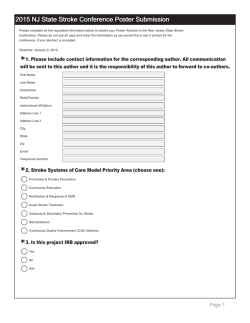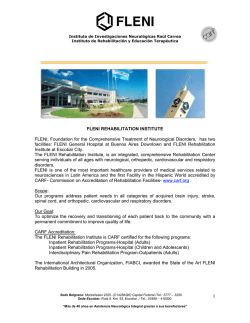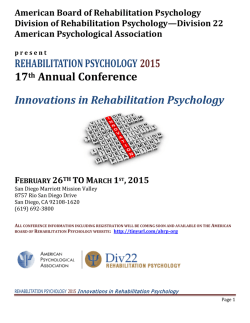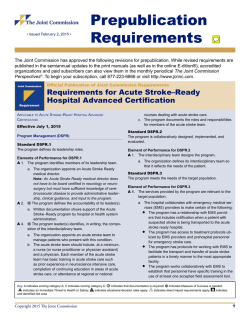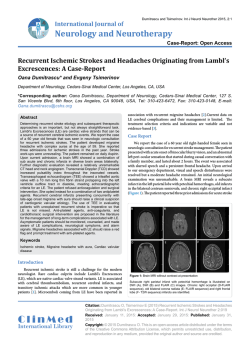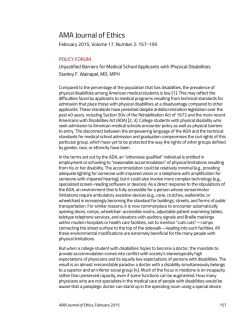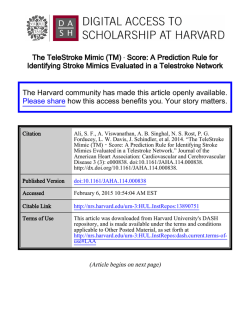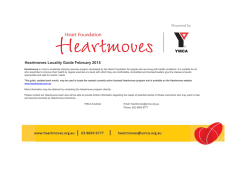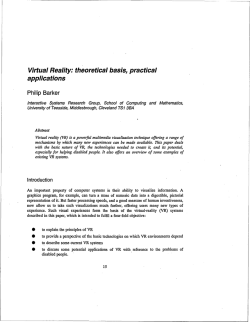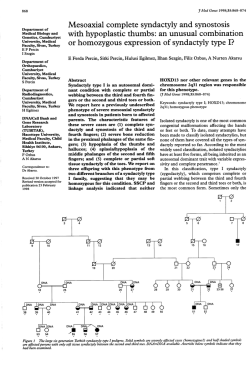
Download a summary of results.
Gloreha (Hand Rehabilitation Glove): summary of clinical results February 2015 – Revision C Although Gloreha (Hand Rehabilitation Glove) is a new device, its effectiveness has already been verified thanks to some clinical trials which involved: post-stroke patients in the sub-acute phase (up to a maximum of 90 days after the event; MAS≤3)1,2,3,4,5; post-stroke patients in the chronic phase (MAS≤3)6,7,8,9,10,11,12; 1 Vanoglio F., Luisa A., Garofali F., Mora C.; Evaluation of the effectiveness of Gloreha (Hand Rehabilitation Glove) on hemiplegic patients. Pilot study; presented at XIII Congress of Italian Society of Neurorehabilitation, 18-20 April 2013, Bari (Italy). 2 Parrinello I., Faletti S., Santus G.; Use of a continuous passive motion device for hand rehabilitation: clinical trial on neurological patients; presented at the 41st National Congress of Italian Society of Medicine and Physical Rehabilitation, 14-16 October 2013, Rome (Italy). 3 Montecchi M.G., Volta B., Tettamanzi S., Pederzini E., Lombardi F.; Effectiveness of the hand treatment with Gloreha rehabilitation glove on post-stroke patients after focal cerebral ischemia: randomized trial, with cross-over design; presented at the 42nd National Congress of the Italian Society of Physical and Rehabilitative Medicine, 28 September-1 October 2014, Turin (Italy). 4 Molteni F., Mulè C., Caimmi M., Taveggia G., Missud S., Bianchi P.; Use of continuous passive motion device for the hand on post-stroke patients: pilot study. Presented at the 39th National Congress of Italian Society of Medicine and Physical Rehabilitation, 16-19 October 2011, Reggio Calabria (Italy). 5 Bissolotti L., Gobbo M., Gaffurini P., Orizio C., Changes in Skeletal Muscle Perfusion on Patients with Post-stroke Hemiparesis Treated by Robotic Assistance (Gloreha) of Hand: A Case Series; submitted to the 9th World Congress of the International Society of Physical and Rehabilitation Medicine, 19 - 23 June 2015, Berlin (Germany). 6 Bissolotti L., Robotic rehabilitation of the upper limb after stroke: analysis of peripheral vascular adaptations during Gloreha treatment; presented at XIV Congress of Italian Society of Neurorehabilitation, 8-10 May 2014, Genova (Italy). 7 Bissolotti L., Symptomatic treatment with Gloreha after stroke: effects on pain and spasticity; presented at XIV Congress of Italian Society of Neurorehabilitation, 8-10 May 2014, Genova (Italy). 8 Bissolotti L., Gobbo M., Gaffurini P., Orizio C., Changes in Spasticity on Patients with Post-stroke Hemiparesis Treated by Robotic Assistance (Gloreha) of Hand: A Case Series; submitted to the 9th World Congress of the International Society of Physical and Rehabilitation Medicine, 19 - 23 June 2015, Berlin (Germany). 1 post-stroke patients treated with botulinum toxin13,2,11; post-stroke patients with hemispatial neglect (right-hemisphere brain damage due to first-ever ischemic stroke; MAS<3)14,15,2; hemiparetic patients after neuro-oncological surgery (hand function deficit; MAS≤3)16; other neurological patients: patients affected by multi-neurite, traumatic brain injury, meningioma of the spinal cord2; patients affected by musculoskeletal diseases17. Clinical results and scientific evidences about Gloreha were presented on scientific journals and/or during National and International Rehabilitation Conferences. For example: Journal of NeuroEngineering and Rehabilitation: Varalta V, Picelli A, Fonte C, Montemezzi G, La Marchina E, Smania N, Effects of contralesional robot9 Bissolotti L., Gobbo M., Gaffurini P., Orizio C., The perceived effectiveness after Gloreha treatment in patients with stroke: a comparison with Physical Therapists judgment; submitted to the 9th World Congress of the International Society of Physical and Rehabilitation Medicine, 19 - 23 June 2015, Berlin (Germany). 10 Gastaldo M., Azzolin I., Gobbi M., Re A., Vrenozi H., Minuto A., Rolle S., Campagnoli M., Massazza G., Use of the robotic device Gloreha (Hand Rehabilitation Glove) for rehabilitation treatment of a patient affected by brachial hemiparesis after stroke: case report; presented at 42nd National Congress of the Italian Society of Physical and Rehabilitative Medicine, 28 September-1 October 2014, Turin (Italy). 11 Rolle S. (supervisor: Massazza G.), Conditions for the use of robotic hand in hemiplegic patients; doctoral dissertation 2014, Università degli Studi di Torino (Italy). 12 Vanoglio F., Mulè C., Bernocchi P., Salvi L., Galli T., Luisa A., Taveggia G., Gloreha project for telerehabilitation: a home rehabilitation device for patients with hand deficits; presented at 42nd National Congress of the Italian Society of Physical and Rehabilitative Medicine, 28 September-1 October 2014, Turin (Italy). 13 Stagno D., Baricich A., Invernizzi M., Grana E., Cisari C.; Use of a robotic device in the rehabilitation treatment after botulinum toxin (type A) injection on spastic upper limb after stroke. Pilot study; presented at XIII Congress of Italian Society of Neurorehabilitation, 18-20 April 2013, Bari (Italy). 14 Varalta V, Picelli A, Fonte C, Montemezzi G, La Marchina E, Smania N; Effects of contralesional robot-assisted hand training in patients with unilateral spatial neglect following stroke: a case series study; J Neuroeng Rehabil. 2014 Dec 5. 15 Varalta V., Smania N., Geroin C., Fonte C., Gandolfi M., Picelli A., Munari D., Ianes P., Montemezzi G., La Marchina E.; Effects of passive rehabilitation of the upper limb with robotic device Gloreha on visual-spatial and attentive exploration capacities of patients with stroke issues; presented at Congress “Riabilitazione: una scienza in cammino”, 18-20 March 2013, La Villa (Bolzano - Italy) and XIII Congress of Italian Society of Neurorehabilitation, 18-20 April 2013, Bari (Italy). 16 Rodigari A, Zancan A, Jedrychowska I, Springhetti I; Evaluation of the effectiveness of Gloreha (Hand Rehabilitation nd Glove) on hemiplegic patients. Pilot study; Proceedings of the 42 National Congress of the Italian Society of Physical and Rehabilitative Medicine, Edizioni Minerva Medica, in course of printing. 17 Bissolotti L., Gobbo M., Gaffurini P., Orizio C., The use of Gloreha Idrogenet in the clinical setting: a retrospective analysis of 18 months experience; submitted to the 9th World Congress of the International Society of Physical and Rehabilitation Medicine, 19 - 23 June 2015, Berlin (Germany). 2 assisted hand training in patients with unilateral spatial neglect following stroke: a case series study; Proceedings of the 42nd National Congress of the Italian Society of Physical and Rehabilitative Medicine: Rodigari A, Zancan A, Jedrychowska I, Springhetti I, Effectiveness of the treatment of hemiplegic patient's hand with robotic rehabilitation glove “Gloreha”: preliminary results; Congresses of Italian Society of Neurorehabilitation; World Congress of the International Society of Physical and Rehabilitation Medicine. Here are some conclusions of the clinical trials carried out on Gloreha: «We retrospectively evaluated the clinical experience in the use of Gloreha. 80 patients (mean ± SD age: 50.1±17.1 years) were extracted from the Gloreha database of 18 months use. (…) Patients were affected by a Central Nervous System (stroke, brain injury) in 69.2% of the cases, in 4.2% by Peripheral Nervous System, in 6.7% by Spinal Cord Injury and in 9% by musculoskeletal injury. (…) In clinical setting Gloreha can be used for a wide range of upper limb disabilities. Dropout rate is negligible and determined exclusively by severe spasticity. Gloreha showed high mechanical resistance along with time»17. «Unlike other types of conventional physical therapy, the Gloreha machine allows to initiate at the bedside early treatment with a high number of repetitions of passive movement sequences in combination with real-time 3D animation of hand movements shown on a monitor positioned in the patient’s contralesional visual field (extrapersonal space)»14. «At the end of Gloreha glove training, preliminary results indicate that patients with hemiplegia occurred after brain tumour removal show that a visible improvement in upper limb function, motor skills of the hand and dexterity, without pain. (…) The Gloreha glove can be a satisfying integration of the standard rehabilitation treatment»16. «Gloreha seems to be suitable as a device to control spasticity, also after Botox injection. The mobilization performed by the device induced a reduction of muscle tone of hand and wrist in about the half of the patients»11. «Our findings indicate that robot-assisted left (contralesional) hand training may improve not only visuospatial exploration and attention but also speed 3 to execute gross movement of the arm, hand and fingers, as well as fingertip dexterity in stroke patients with hemispatial neglect»14. «According to our data we can assume that, in the hand treatment, the device Gloreha is not inferior to the standard treatment, that requires the presence of physiotherapists. (…) It is evident that the use of Gloreha in a rehabilitation program allows to increase considerably and, at a limited cost, the time of treatment of the hand in hemiplegic patients, without increasing the efforts by physiotherapists»1. «At the end of the rehabilitation treatment with the robotic glove Gloreha we noted: reduction of hypertonia, improvement of grip, ROM, functional skills of hemiparetic upper limb and quality of life perceived by the patient. The treatment was performed with a high level of patient’s compliance. We think that the advantageous cost-benefit ratio and the high levels of compliance, safety and satisfaction make Gloreha a valuable rehabilitation solution, complimentary with conventional approaches for cerebrovascular patients»10. «In the treatment of hand paralysis after stroke, robot-assisted mobilization with Gloreha is generally positively rated by patients and, compared to physical therapists, a good agreement is existing about the potential functional benefit on mobility, pain and stiffness improvement»9. «We split 32 sub-acute post-stroke patients in two groups: a group was treated with Gloreha (15 sessions, 30 minutes per session), the control group was treated in a conventional way (15 sessions, 30 minutes per session). Both groups showed a significant improvement of functional recovery and motor capabilities and a reduction of pain, but the group treated with Gloreha achieved better results in terms of Barthel Index, quickDASH, Motricity Index and VAS (for pain assessment)»18. «We applied Gloreha on sub-acute patients with flaccid flexors and spastic patients treated with Botox injection. In both cases, Gloreha treatment was successfully included in an integrated rehabilitation approach, composed of mobilization and electrical stimulation of fingers extensors. We are also combining Gloreha with tDCS, according to protocols under study»19. «The patients liked the home treatment with Gloreha and performed the rehabilitation sessions with a high level of compliance. Our experience shows an interesting chance to continue the rehabilitation treatment after the hospital discharge, in order to improve the integration between hospital and community»12. 18 Taveggia G.; Gloreha: more intensive and effective rehabilitation, at hospital and home; Tecnologie Riabilitative 2014 November 3. 19 Molteni F.; Gloreha gives post-stroke rehabilitation a helping hand; Tecnologie Riabilitative 2014 September 2. 4 In particular, here are the clinical benefits recorded during the trials: Gloreha can increase grip and pinch strength on the paretic side of neurological patients in the sub-acute phase. Gastaldo et al., 2014. The case report is related to a chronic patient affected by hemiparesis (stroke occurred 8 months before the first Gloreha session). The patient was treated with Gloreha for 4 weeks (5 sessions per week, 25 minutes per session). During the therapy, Gloreha glove mobilized the fingers while the patient followed the movement on the screen thanks to the 3D simulation. After 4 weeks a significant improvement of strength was verified, as shown in the chart below. 5 4 4 4 3 4 3 3 3 3 3 2 2 MRC Before the treatment 2 1 1 After the treatment 1 0 Wrist flexors Flexor Flexor digitorum digitorum superficialis profundus Thumb flexors Fingers extensors Pinch I-II Vanoglio et al., 2013. The group treated with Gloreha developed a higher increment of the strength at the Grip and the Pinch test in comparison with the control group. The treatment consisted of 30 sessions; the duration of each session was 40 minutes. The patients included in the control group were treated by therapists for the same time as the group treated with Gloreha. 120% 113.29% 100% 78.32% 80% 72% 60% Group treated with Gloreha 40% Control group 20% 13.87% 0% Grip test Pinch test 5 Gloreha can improve functional independence of neurological patients, especially in the sub-acute phase. Rodigari et al., 2014. The clinical trial is involving hemiparetic patients after neuro-oncological surgery. The treatment with Gloreha consists of 20 sessions; the duration of each session is 60 minutes. The charts below show the preliminary results related to 12 patients (p<0.001): at the end of the treatment, the FIM mean gain (Delta) is 23.44 points (from 68.78 to 92.22), while the mean improvement of the motor subscore is 22.66 points (from 38.56 to 61.22). Taking into account the items of the upper limb (personal care: eating, grooming, bathing, dressing, toileting) the mean delta is 9.77 points (from 17.67 to 27.44). The trial is still in progress and also a control group will be enrolled to confirm the preliminary findings. Parrinello et al., 2013. The treatment with Gloreha consisted of 10 daily sessions (30 minutes per session); the patients started the treatment at least 3 weeks since the neurological event. All the 12 recruited patients showed an improvement in functional independence, assessed by FIM. Gastaldo et al., 2014. The case report is related to a chronic patient affected by hemiparesis (stroke occurred 8 months before the first Gloreha session). The patient was treated with Gloreha for 4 weeks (5 sessions per week, 25 minutes per session). During the therapy, Gloreha glove mobilized the fingers while the patient followed the movement on the screen thanks to the 3D simulation. After 4 weeks a significant improvement of functional independence was verified, as shown in the charts below. 6 100 80 80 60 80 52 60 40 30 43 40 20 20 0 T0 (Wolf Motor Function Test) T1 (Wolf Motor Function Test) 0 T0 (Barthel Index) T1 (Barthel Index) Vanoglio et al., 2013. The randomized controlled clinical trial involved 10 post-stroke patients in the subacute phase. The group treated with Gloreha showed a marked average increase evaluated by FIM (Functional Independence Measure) Scale, against a substantial stability in the control group. The treatment consisted of 30 sessions; the duration of each session was 40 minutes. The patients included in the control group were treated by therapists for the same time as the group treated with Gloreha. IRCCS Maugeri Foundation in Lumezzane (Italy) and Habilita Clinic in Sarnico (Italy) are applying the same protocol on further patients, in order to make the sample bigger and get more solid results. 80 70 60 50 40 30 20 10 0 75.8 46.8 46.6 50.2 Before the treatment After the treatment Group treated with Gloreha Control group 7 Gloreha can improve unimanual and bimanual coordination and dexterity of neurological patients, especially in the sub-acute phase. Rodigari et al., 2014. The clinical trial is involving hemiparetic patients after neuro-oncological surgery. The treatment with Gloreha consists of 20 sessions; the duration of each session is 60 minutes. Bimanual dexterity is assessed with Box and Block Test; the chart below shows the preliminary results related to 12 patients: they show a statistically significant improvement (p=0.044), from 20.22 (range: 0-55) to 27.56 (range: 0-62). The trial is still in progress and also a control group will be enrolled to confirm the preliminary findings. 60 50 40 27.56 30 20.22 20 10 0 T0 (Box and Block Test average) T1 (Box and Block Test average) Varalta et al., 2014. Three right-handed patients with right-hemisphere brain damage due to first-ever ischemic stroke were recruited and treated with Gloreha. Each patient underwent a training program consisting of 10 sessions; the duration of each session was 30 minutes. Gloreha was used to perform a robotassisted left (contralesional) hand training. During the first week of treatment, the subjects had to watch the monitor in front of them and name the fingers being moved throughout the training session, while during the second week of treatment they had to name the moving fingers with their eyes closed. The Purdue Pegboard test was used to assess gross movement of the arm, hand and fingers, as well as fingertip dexterity. All patients showed improved performance (100%, 27.3% and 75% change n the left+right+both hands sub.item score). 50 45 40 35 30 25 20 15 10 5 0 Purdue Pegboard Test (left+right+both hands) 28 22 Before the treatment 14 After the treatment 8 6 3 Patient A Patient B Patient C Gastaldo et al., 2014. The case report is related to a chronic patient affected by hemiparesis (stroke occurred 8 months before the first Gloreha session). The patient was treated with Gloreha for 4 weeks (5 sessions per week, 25 minutes per session). During the therapy, Gloreha glove mobilized the fingers while the patient followed the movement on the screen thanks to the 3D simulation. After 4 weeks a significant improvement of upper limb functioning was verified, as shown in the charts below. 8 50 40 30 25 20 14 10 0 T0 (Action Research Arm Test) T1 (Action Research Arm Test) Vanoglio et al., 2013. The evaluation of unimanual (paretic and healthy limb) and bimanual coordination and dexterity shows averages of delta t1-t0 (t1: after the treatment; t0: before the treatment) in the group treated with Gloreha higher than in the control group. The patients were post-stroke in the sub-acute phase. The treatment consisted of 30 sessions; the duration of each session was 40 minutes. The patients included in the control group were treated by therapists for the same time as the group treated with Gloreha. 0.3 0.245 0.25 0.2 0.15 0.138 Group treated with Gloreha 0.1 Control group 0.0496 0.05 0.0159 0.00382 0 -0.05 -0.02 Nine Hole Peg Test Nine Hole Peg Test Pennsylvania bi(healthy side) (paretic side) manual worksample Varalta et al., 2013. At the pre-treatment evaluation, after 4 months since hemorrhagic stroke, the patient F.M. had high difficulty in using the left hand to perform exercises that require good capacities of manual dexterity. After the treatment with Gloreha, the patient showed an improvement in both tests (Purdue PegBoard Test and Nine Hole Peg Test). The treatment was made up of 10 rehabilitation sessions of 25 minutes. 0.8 0.7 0.6 0.5 0.4 0.3 0.2 0.1 0 0.72 0.58 0.24 0.14 Nine Hole Peg Test (healthy side) Before the treatment After the treatment Nine Hole Peg Test (paretic side) 9 Gloreha can increase the motricity (active movement) of neurological patients. Rodigari et al., 2014. The clinical trial is involving hemiparetic patients after neuro-oncological surgery. The treatment with Gloreha consists of 20 sessions; the duration of each session is 60 minutes. The chart below shows the preliminary results related to 12 patients. Motricity Index average data show a statistically significant progression (p=0.036), from 34.78 (range: 0-72) to 47.56 (range: 0-76). The trial is still in progress and also a control group will be enrolled to confirm the preliminary findings. 100 80 60 47.56 34.78 40 20 0 T0 (Motricity Index - average) T1 (Motricity Index - average) Gastaldo et al., 2014. The case report is related to a chronic patient affected by hemiparesis (stroke occurred 8 months before the first Gloreha session). The patient was treated with Gloreha for 4 weeks (5 sessions per week, 25 minutes per session). During the therapy, Gloreha glove mobilized the fingers while the patient followed the movement on the screen thanks to the 3D simulation. After 4 weeks a significant improvement of active movement was verified, as shown in the charts below. 100 66 80 60 56 72 43 46 49 36 40 26 20 16 23 6 0 T0 (Motricity Index) T1 (Motricity Index) -4 T0 (Fugl-Meyer) T1 (Fugl-Meyer) Vanoglio et al., 2013. The patients treated with Gloreha increased their motricity performance (Motricity Index) both on the paretic side and the healthy one more than the patients included in the control group. The treatment consisted of 30 sessions; the duration of each session was 40 minutes. The control group was composed of patients treated by the therapist for the same time as the group treated with Gloreha. 92.7 94.4 100 78.54 72.4 75.9 80 60.2 60 40 15 20 23.9 Before the treatment After the treatment 0 Group treated with Gloreha (healthy side) Control group (healthy side) Group treated with Gloreha (paretic side) Control group (paretic side) 10 Gloreha can decrease or prevent the hypertonia of neurological patients. Bissolotti et al., 2015. The clinical trial involved 11 chronic post-stroke patients (at least 6 months after the event; mean age 62.8±12.7 years). They received mobilization of the hand through the Gloreha device for 3 weeks (30 minutes per day, 3 sessions per week). Robotic intervention reduced spasticity after intervention by 75% in wrist and fingers (1.4±1.1 at T0; 0.4±0.6 at T1; p<0.05). Rolle, 2014. The clinical trial involved 16 hemiplegic patients (onset-admission range: 9-324 months). 14 patients were also treated with Botox injection before starting the Gloreha protocol. 6 patients underwent 20 Gloreha sessions, 10 patients underwent 10 Gloreha sessions (28 minutes per session, 5 sessions per week). The charts below show the MAS values, before and after treatment, patient by patient. The first chart is related to the muscle tone of wrist flexors: 31,25% of the patients showed a decrease, 68,75% didn’t show any change, no one showed an increment of spasticity. The second chart is related to flexor digitum profundus: 43,75% of the patients showed a decrease, 50% didn’t show any change, just in one case the tone slightly increased (1 point on MAS). The last chart is related to flexor digitum superficialis: 43,75% of the patients showed a decrease, 56,25% didn’t show any change, no one showed an increment of spasticity. Wrist flexors Flexor digitum profundus Flexor digitum superficialis 11 Bissolotti et al., 2014. The clinical trial was carried out on 11 chronic patients after stroke (onset-admission interval: 96.3±125.1 months). The treatment with Gloreha consisted of 10 daily sessions; the duration of each session was 30 minutes. The researchers assessed significant clinical benefits in terms of muscle tone reduction. The chart below shows the results collected at T0 (before the first treatment session with Gloreha), T1 (after the first treatment session with Gloreha), T2 (before the last treatment session with Gloreha), T3 (after the last treatment session with Gloreha). Modified Ashworth scores 4,0 T0 T1 T2 T3 3,5 Ashworth scores 3,0 2,5 2,0 1,5 1,0 0,5 0,0 Wrist ext. Fingers ext. Gastaldo et al., 2014. The case report is related to a chronic patient affected by hemiparesis (stroke occurred 8 months before the first Gloreha session). The patient was treated with Gloreha for 4 weeks (5 sessions per week, 25 minutes per session). During the therapy, Gloreha glove mobilized the fingers while the patient followed the movement on the screen thanks to the 3D simulation. After 4 weeks a significant reduction of spasticity was verified, as shown in the chart below. 2 MAS (Modified Ashworth Scale): 2 Before the treatment 1 1 After the treatment 1 0 Wrist flexors Flexor digitorum superficialis Flexor digitorum profundus Varalta et al., 2013. The post-stroke patient B.M. in the chronic phase (35 months after the event) showed a lower level of spasticity of the fingers after the treatment with Gloreha (from MAS=2 to MAS=1). The treatment consisted of 10 sessions (25 minutes per session). Vanoglio et al., 2013. The tone of patients treated with Gloreha didn’t evolve into spasticity or, in a few cases, just a slight increase of spasticity was recorded. The clinical trial involved post-stroke patients in the sub-acute phase: they were treated 40 minutes for 30 days. Stagno et al., 2013. 8 post-stroke patients in the chronic phase showed a decrease in spasticity after 1 week and 1 month since the injection of BoNT-A (botulinum toxin type A) and the start of treatment with Gloreha. 12 4 3.7 3.5 3 2.5 2 1.5 Before the treatment 1.5 1.4 After 1 week After 1 month 1 0.5 0 Finger flexors MAS 13 Gloreha can reduce the oedema of neurological patients. Montecchi et al., 2014. The clinical trial involved 23 patients after stroke. It was a randomized trial, with cross-over design. The treatment with Gloreha consisted of 5 daily sessions; the duration of each session was 42 minutes. The outcomes verified the effectiveness of Gloreha for oedema reduction (p=0.039): the patients treated by Gloreha showed a significant reduction (-10.65 mm; min: -49.14 mm; max: +27.84 mm) while the patients treated in a conventional way showed an increment (+4.83 mm; min: -21.37 mm; max: +31.02 mm). 10 4.83 5 0 Gloreha Group Control Group delta hemiplegic hand volume -5 -10 -10.65 -15 Vanoglio et al., 2013. All the patients, treated with Gloreha or by a therapist, decreased the level of oedema. The clinical trial involved post-stroke patients in the sub-acute phase: they were treated 40 minutes for 30 days. Molteni at al., 2011. After the treatment with the prototype of Gloreha 5 out of 7 post-stroke patients with oedema showed a reduction of their symptoms. 14 Gloreha can improve vascular pulsatility of flexors of paretic upper limb on post-stroke patients. Bissolotti et al., 2015. 7 post-stroke patients (up to a maximum of 6 months after the event) were recruited. They were treated with Gloreha for 3 weeks (30 minutes per day, 3 sessions per week). The outcome measures were hemoglobin (THb) profiles and tissue oxygenation index (TOI) in the muscle tissue evaluated through Near-infrared spectroscopy (NIRS, NIMO system, Nirox Optoelectronics). Significant improvements were found in THb (p=0.033). Gloreha induced significant changes in local muscle blood flow and oxygen supply, contributing to decrease the subject reported symptoms of heaviness and stiffness in patients with post-stroke hemiparesis. Bissolotti et al., 2014. The clinical trial was carried out on 11 chronic patients after stroke (onset-admission interval: 96.3±125.1 months). The treatment session with Gloreha lasted for 20 minutes. The researchers, thanks to Near Infrared Spectroscopy (NIRS), assessed clinical benefits of Gloreha in terms of improvement in local blood stream, improvement in capillary elasticity and improvement in proliferation of capillary and cellular density around the fibres. In particular significant THb changes were assessed (THb is the total hemoglobin index). The sum of THB pick changes was 19.32±8.20 (5.21±1.78% compared with basal value). 15 Gloreha can decrease patients’ perception of heaviness, stiffness and pain on upper limb. Bissolotti et al., 2014. The clinical trial was carried out on 11 chronic patients after stroke (onset-admission interval: 96.3±125.1 months). The treatment with Gloreha consisted of 10 daily sessions; the duration of each session was 30 minutes. The researchers assessed significant clinical benefits in terms of patients’ perception. The chart below shows the results collected at T0 (before the first treatment session with Gloreha), T1 (after the first treatment session with Gloreha), T2 (before the last treatment session with Gloreha), T3 (after the last treatment session with Gloreha). Wrist-fingers heaviness perception passed from 34.5±31.2 at T0 to 19.5±19.2 at T1; wrist-fingers stiffness perception passed from 43.6±23.7 to 25.5±19.6. Variation of wrist-fingers heaviness perception Variation of wrist-fingers stiffness perception Variation of wrist-fingers pain perception 16 Rodigari et al., 2014. The clinical trial is involving hemiparetic patients after neuro-oncological surgery. The treatment with Gloreha consists of 20 sessions; the duration of each session is 60 minutes. The chart below shows the preliminary results related to 12 patients: pain is assessed through VAS Scale. VAS average was 1.33 (range: 0-3) at the beginning of treatment; it is 0.66 (range: 0-4) after the treatment (p=0.219). The trial is still in progress and also a control group will be enrolled to confirm the preliminary findings. 1.4 1.33 1.2 1 0.8 0.66 0.6 0.4 0.2 0 T0 (VAS - average) T1 (VAS - average) 17 Gloreha can improve visuospatial exploration and attention in post-stroke patients with hemispatial neglect. Varalta et al., 2014. Three right-handed patients with right-hemisphere brain damage due to first-ever ischemic stroke were recruited and treated with Gloreha. Each patient underwent a training program consisting of 10 sessions; the duration of each session was 30 minutes. Gloreha was used to perform a robotassisted left (contralesional) hand training. During the first week of treatment, the subjects had to watch the monitor in front of them and name the fingers being moved throughout the training session, while during the second week of treatment they had to name the moving fingers with their eyes closed. Line Crossing test is a visual search task that examines the patient’s ability to locate and cancel target stimuli in the neglected hemispace. All patients showed improved performance (6.7%, 89.5% and 80% increase in lines crossed) with two patients reaching normal performance levels. 18 18 18 16 14 14 12 Line Crossing test (left) 12 10 10 Before the treatment 8 6 After the treatment 6 4 2 0 Patient A Patient B Patient C The Bells test allows for a qualitative and quantitative assessment of hemispatial neglect in the near extrapersonal space. One patient improved performance (50% increase), while one patient showed no change and one patient declined (-10.3% change). 35 30 30 29 26 25 20 21 21 20 Bells test Before the treatment 15 After the treatment 10 5 0 Patient A Patient B Patient C The Sentence Reading test examines the ability to read sentences written from left to right. All patients showed improved performance (800%, 57.1% and 42,9% increase in number of sentences read). 18 12 11 10 10 8 7 8 7 Sentence Reading test 6 Before the treatment 4 After the treatment 2 0 0 Patient A Patient B Patient C The Saccadic Training - subtest of the RehaCom® software - was used to evaluate the reaction time for right and left stimuli. All patients showed improved performance (-62.8%, -15.5% and -9.7% change of the left hemifield reaction time). 8000 7252 7000 5726 6000 5169 5000 Saccadic training (left) Before the treatment 4000 2698 3000 2411 After the treatment 2038 2000 1000 0 Patient A Patient B Patient C The Sustained Attention to Response Task is a reaction time task for sustained attention and cognitive control that evaluates the ability to sustain attention with a response-suppression element. All patients showed improved performance (-20.5%, -5.8% and -10% change of the reaction time) with two patients reducing also incorrect responses (-42.9% and -73.3%) and one patient increasing them (9.1%). 700 600 500 612 551 511 406 452 426 Sustained Attention to Response Task 400 Before the treatment 300 After the treatment 200 100 0 Patient A Patient B Patient C 19 Gloreha is well tolerated by patients: all the tests show a high compliance level. Gloreha can increase the time of treatment, at a limited cost: Gloreha can bring a significant advantage in economic terms and enable the reallocation of human resources (i.e. therapists). Vanoglio et al., 2013. The cost of traditional treatment, performed by therapist, was higher than the cost of Gloreha treatment (the time necessary for the therapist to use the device was considered; the cost of the device was not considered). The treatment was composed of 30 rehabilitation sessions (40 minutes per session). 400 € 336.00 350 300 250 Group treated with Gloreha 200 150 € 100.52 Control group 100 50 0 Cost per patient New clinical trials are in progress to substantiate and expand the results mentioned above, using a bigger sample size and also testing Gloreha on patients with further diseases as spinal cord injury. Specific studies are going on to: measure the phenomena of brain plasticity promoted by Gloreha, thanks to a fMRI (Functional Magnetic Resonance Imaging) and quantitative analysis of EEG; measure the clinical benefits of a combined application Gloreha rehabilitation glove + Gloreha DAS (Dynamic Arm Support); measure the clinical benefits of the home treatment performed with Gloreha Lite (multicenter clinical trial). 20 Gloreha was developed in accordance with the conclusions of the most recent scientific literature: a rehabilitation treatment after stroke has to be intensive, repetitive, functional, task-oriented, specific, customizable20,21; biomechatronic devices, robotic systems and computer interfaces can be useful for facilitating functional recovery and reducing motor impairment of upper limb22,23,24,25; a repetitive training program based on flexion and extension of the fingers can improve the function of plegic hand after stroke: it can reduce the oedema, maintain or increase the range of motion and muscle lengths, prevent spasticity26,27,28,29,30; passive stretch can prevent connective tissue accumulation in muscle31 and help motor learning32,33,34; 20 Kollen BJ, Lindeman E. Understanding the pattern of functional recovery after stroke: Facts and theories. Restorative Neurology and Neuroscience 2004;22:281–299 21 Van Peppen RP, Kwakkel G, Wood-Dauphinee S, Hendriks HJ, Van der Wees PJ, Dekker J. The impact of physical therapy on functional outcomes after stroke: what’s the evidence? Clin Rehabil 2004;18:833–62. 22 Masiero S, Celia A, Rosati G, Armeni M. Robotic-assisted rehabilitation of the upper limb after acute stroke. Arch Phys Med Rehabil 2007;88:142-9. 23 Kiguchi K, Iwami K, Yasuda M, Watanabe K, Fukuda T. An exoscheleton robot for human shoulder joint motion assis. IEEE/ASME Trans Mech 2003;8:126-36. 24 Hesse S, Schulte-Tigges G, Konrad M, Bardeleben A, Werner C. Robot-assisted arm trainer for the passive and active practice of bilateral forearm and wrist movement in hemiparetic subjects. Arch Phys Med Rehab 2003;84:915-20. 25 Volpe B, Krebs H, Hogan N, Edelsteim L, Diels C, Aisen M. A novel approach to stroke rehabilitation: Robot aided sensorimotor stimulation. Neurology 1999;54:1938-44. 26 Carey JR, Kimberley TJ, Lewis SM, et al. Analysis of fMRI and finger tracking training in subjects with chronic stroke. Brain 2002;125(pt 4):773-88. 27 Carey JR, Durfee WK, Bhatt E, et al. Comparison of finger tracking versus simple movement training via telerehabilitation to alter hand function and cortical reorganization after stroke. Neurorehabil Neural Repair 2007;21:216-32. 28 Giudice M.L. Effects of Continuos Passive Motion and elevation on hand edema. The American Journal of Occupational Theraphy, 1990; Oct; 44(10):914-21 29 Dirette D., Hinojosa J. Effects of continuos passive motion on the edematous hands of two persons with flaccid hemiplegia. The American Journal of Occupational Theraphy, 1994; May; 48(5):403-409. 30 Xu X.L., Tong R.K., Song R., Zheng X.J., Leung W. W. A comparison between electromyography-driven robot and passive motion device on wrist rehabilitation for chronic stroke. Neurorehabiltation and neural repair, 2009; Jun 16 31 Williams P E, Catanese T, Lucey E G, Goldspink G: The importance of stretch and contractile activity in the prevention of connective tissue accunulation in muscle. J Anat 1988; 158: 109-114. 32 Seitz et al. A common frame work for perceptual learning. Curr. Neurobiol 2007, 17:1-6. 33 Winter et al. Hands-on theraphy intervention for upper limb motor dysfunction following stroke. Cochrane Database Syst Rev 2011 Jun 15; 6:CD006609. 21 the exercises with devices works on plastic processes in the central nervous system thanks to neuromotor, visual and audio feedback: multi-sensory action-observation systems enable patients to re-learn impaired motor functions through the activation of internal action-related 35,36 representations ; motor imagery, passive movement, movement observation, hand exercises in VR (Virtual Reality) can activate sensorimotor areas of the brain37,38,39,40,41. Gloreha can be used in accordance with the most advanced rehabilitation treatments: Motor Imagery, Mirror Therapy, Constraint-induced Therapy, Bimanual Training. 34 Hwang CH, Seong JW, Son DS. Individual finger synchronized robot-assisted hand rehabilitation in subacute to chronic stroke: a prospective randomized clinical trial of efficacy. Clinical Rehabilitation 2012;26(8); 696–704. 35 Lee MM, Cho HY, Song CH. The mirror therapy program enhances upper-limb motor recovery and motor function in acute stroke patients. Am J Phys Med Rehabil 2012;91(8):689-96 36 Sale P, Franceschini M. Action observation and mirror neuron network: a tool for motor stroke rehabilitation. Eur J Phys Rehabil Med. 2012 Jun;48(2):313-8. Epub 2012 Apr 20. 37 Szameitat AJ, Shen S, Conforto A, Sterr A. Cortical activation during executed, imagined, observed, and passive wrist movements in healthy volunteers and stroke patients. Neuroimage. 2012 Aug 1;62(1):266-80. doi: 10.1016/j.neuroimage.2012.05.009. Epub 2012 May 11 38 August K, Lewis JA, Chandar G, Merians A, Biswal B, Adamovich S. FMRI analysis of neural mechanisms underlying rehabilitation in virtual reality: activating secondary motor areas. Conf Proc IEEE Eng Med Biol Soc. 2006;1:3692-5. 39 Tunik E, Saleh S, Adamovich SV. Visuomotor discordance during visually-guided hand movement in virtual reality modulates sensorimotor cortical activity in healthy and hemiparetic subjects. IEEE Trans Neural Syst Rehabil Eng. 2013 Mar;21(2):198-207. doi: 10.1109/TNSRE.2013.2238250. Epub 2013 Jan 9. 40 Saleh S, Bagce H, Qiu Q, Fluet G, Merians A, Adamovich S, Tunik E. Mechanisms of neural reorganization in chronic stroke subjects after virtual reality training. Conf Proc IEEE Eng Med Biol Soc. 2011;2011:8118-21. doi: 10.1109/IEMBS.2011.6092002. 41 Tunik E, Adamovich SV. Remapping in the ipsilesional motor cortex after VR-based training: a pilot fMRI study. Conf Proc IEEE Eng Med Biol Soc. 2009;2009:1139-42. doi: 10.1109/IEMBS.2009.5335392. 22
© Copyright 2026
